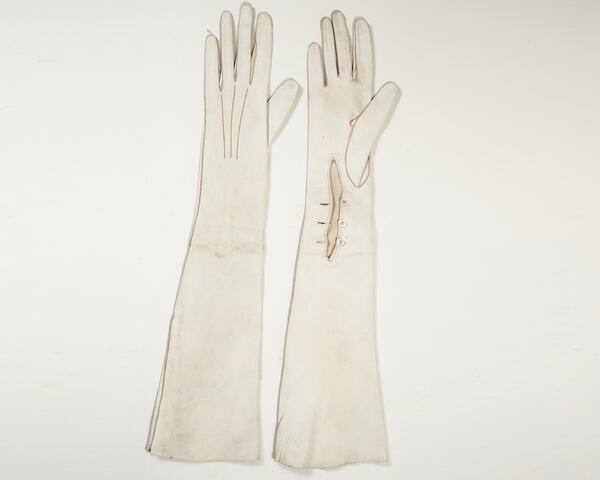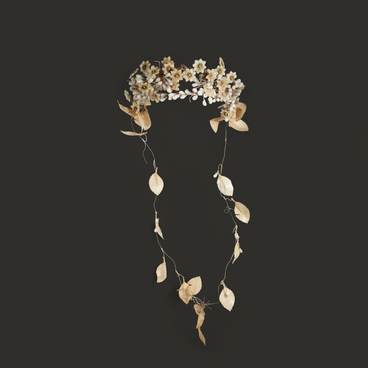Gloves were the most important accessory of women’s costume in the 19th century. The etiquette for women prescribed to wear them without taking off, and it was necessary to have a spare pair for a situation when the gloves might get dirty or torn. Usually, the gloves were made of silk or fine leather as this exhibit from the museum collection.
Every woman, who followed the fashion, had at least 15 pairs of gloves in her wardrobe. As a rule, the gloves worn at the balls had light colors and matched the dress. Usually, they were higher than the elbow and fit the arms tightly. Sometimes it was necessary to use a special tool called “raspyalka”, which was made from ivory, because the gloves were extremely tight and had to be stretched. This is the reason why the objects that were made of kidskin fine white leather have shrunk and look extremely small nowadays. It was also difficult to fasten these gloves, and special hooks were required.
“The most elegant gloves are white kidskin gloves, especially for the evening outings. They get dirty very fast, that is why they are worn less often during the day. Tucking up the skirt, opening a door, or holding an umbrella was enough to soil the gloves. Gray or beige gloves are a better choice in this case. Black gloves should only be worn with a black dress, ” advised the “The Ability to Dress Well” book in 1911.
The length of the gloves depended on the length of the dress sleeve: the shorter the ballroom dress sleeve was, the longer the gloves had to be. Rings were not to be worn on top of the gloves — it was considered tasteless and was associated with the merchant class women’s clothes. This style was also known as the ‘fake aristocracy’.
The gloves from the museum collection are made of kidskin leather. This kind of especially soft leather was used for manufacturing delicate, flexible gloves. These gloves retained their shape and had a fine glossy appearance. The leather gloves were kept in special boxes together with the ‘raspyalka’ and other accessories.
In Russia, the use of kidskin for manufacturing started in the 19th century and became very popular. The gloves were handmade until the 1850s, when a special machine was invented to press the edges of the gloves for a perfect fit.
The exhibit from the museum collection was donated to the collection by Tamara Kiselnikova, who lived in the town of Zavolzhye in the Gorodets region.
Every woman, who followed the fashion, had at least 15 pairs of gloves in her wardrobe. As a rule, the gloves worn at the balls had light colors and matched the dress. Usually, they were higher than the elbow and fit the arms tightly. Sometimes it was necessary to use a special tool called “raspyalka”, which was made from ivory, because the gloves were extremely tight and had to be stretched. This is the reason why the objects that were made of kidskin fine white leather have shrunk and look extremely small nowadays. It was also difficult to fasten these gloves, and special hooks were required.
“The most elegant gloves are white kidskin gloves, especially for the evening outings. They get dirty very fast, that is why they are worn less often during the day. Tucking up the skirt, opening a door, or holding an umbrella was enough to soil the gloves. Gray or beige gloves are a better choice in this case. Black gloves should only be worn with a black dress, ” advised the “The Ability to Dress Well” book in 1911.
The length of the gloves depended on the length of the dress sleeve: the shorter the ballroom dress sleeve was, the longer the gloves had to be. Rings were not to be worn on top of the gloves — it was considered tasteless and was associated with the merchant class women’s clothes. This style was also known as the ‘fake aristocracy’.
The gloves from the museum collection are made of kidskin leather. This kind of especially soft leather was used for manufacturing delicate, flexible gloves. These gloves retained their shape and had a fine glossy appearance. The leather gloves were kept in special boxes together with the ‘raspyalka’ and other accessories.
In Russia, the use of kidskin for manufacturing started in the 19th century and became very popular. The gloves were handmade until the 1850s, when a special machine was invented to press the edges of the gloves for a perfect fit.
The exhibit from the museum collection was donated to the collection by Tamara Kiselnikova, who lived in the town of Zavolzhye in the Gorodets region.



